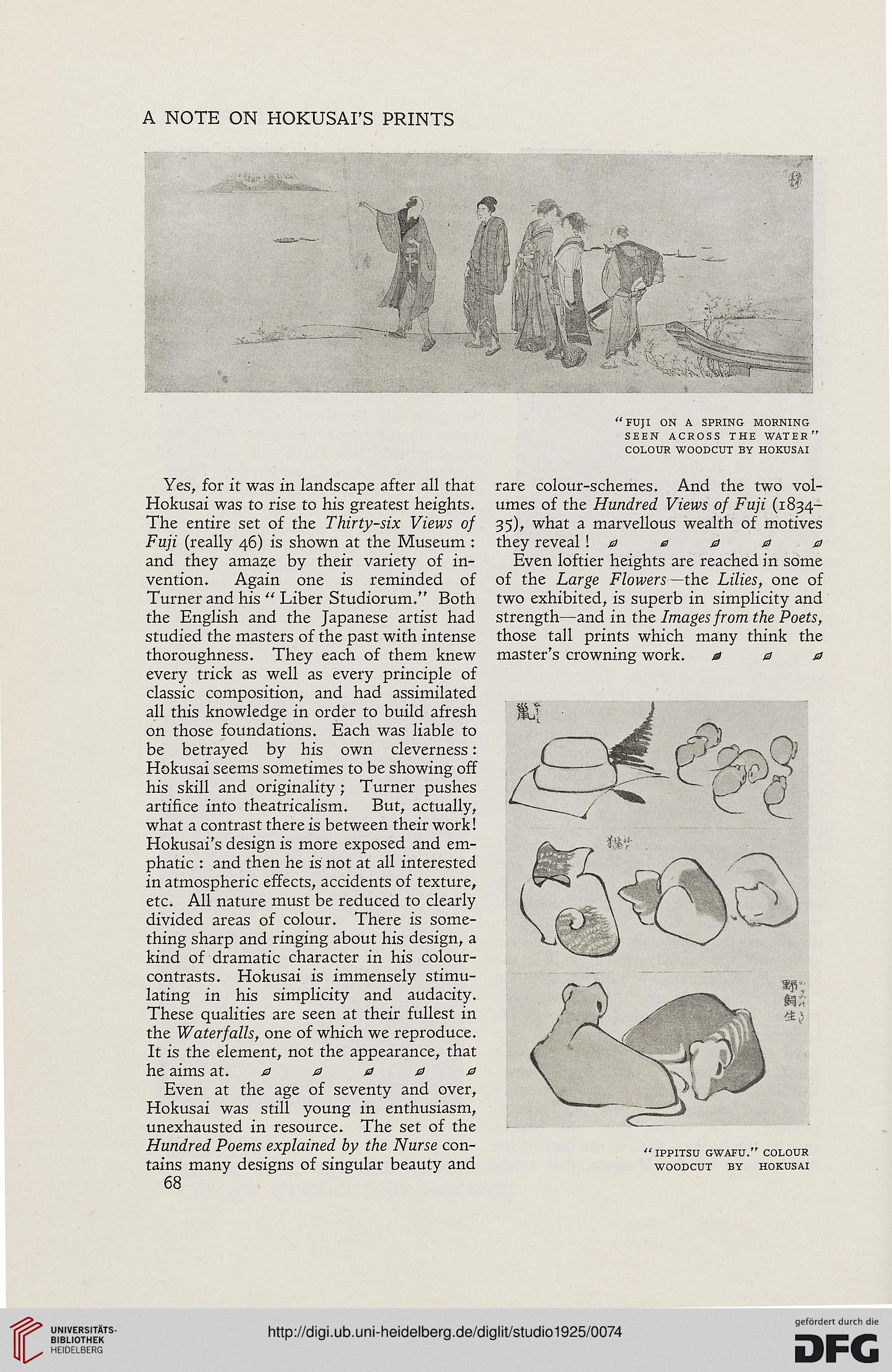A NOTE ON HOKUSAI'S PRINTS
Yes, for it was in landscape after all that
Hokusai was to rise to his greatest heights.
The entire set of the Thirty-six Views of
Fuji (really 46) is shown at the Museum :
and they amaze by their variety of in-
vention. Again one is reminded of
Turner and his " Liber Studiorum." Both
the English and the Japanese artist had
studied the masters of the past with intense
thoroughness. They each of them knew
every trick as well as every principle of
classic composition, and had assimilated
all this knowledge in order to build afresh
on those foundations. Each was liable to
be betrayed by his own cleverness:
Hokusai seems sometimes to be showing off
his skill and originality; Turner pushes
artifice into theatricalism. But, actually,
what a contrast there is between their work!
Hokusai's design is more exposed and em-
phatic : and then he is not at all interested
in atmospheric effects, accidents of texture,
etc. All nature must be reduced to clearly
divided areas of colour. There is some-
thing sharp and ringing about his design, a
kind of dramatic character in his colour-
contrasts. Hokusai is immensely stimu-
lating in his simplicity and audacity.
These qualities are seen at their fullest in
the Waterfalls, one of which we reproduce.
It is the element, not the appearance, that
he aims at. 0 0 00 0
Even at the age of seventy and over,
Hokusai was still young in enthusiasm,
unexhausted in resource. The set of the
Hundred Poems explained by the Nurse con-
tains many designs of singular beauty and
68
" FUJI ON A SPRING MORNING
SEEN ACROSS THE WATER"
COLOUR WOODCUT BY HOKUSAI
rare colour-schemes. And the two vol-
umes of the Hundred Views of Fuji (1834-
35), what a marvellous wealth of motives
they reveal! 0 0 0 0 0
Even loftier heights are reached in some
of the Large Flowers —the Lilies, one of
two exhibited, is superb in simplicity and
strength—and in the Images from the Poets,
those tall prints which many think the
master's crowning work. 000
"IPPITSU GWAFU." COLOUR
WOODCUT BY HOKUSAI
Yes, for it was in landscape after all that
Hokusai was to rise to his greatest heights.
The entire set of the Thirty-six Views of
Fuji (really 46) is shown at the Museum :
and they amaze by their variety of in-
vention. Again one is reminded of
Turner and his " Liber Studiorum." Both
the English and the Japanese artist had
studied the masters of the past with intense
thoroughness. They each of them knew
every trick as well as every principle of
classic composition, and had assimilated
all this knowledge in order to build afresh
on those foundations. Each was liable to
be betrayed by his own cleverness:
Hokusai seems sometimes to be showing off
his skill and originality; Turner pushes
artifice into theatricalism. But, actually,
what a contrast there is between their work!
Hokusai's design is more exposed and em-
phatic : and then he is not at all interested
in atmospheric effects, accidents of texture,
etc. All nature must be reduced to clearly
divided areas of colour. There is some-
thing sharp and ringing about his design, a
kind of dramatic character in his colour-
contrasts. Hokusai is immensely stimu-
lating in his simplicity and audacity.
These qualities are seen at their fullest in
the Waterfalls, one of which we reproduce.
It is the element, not the appearance, that
he aims at. 0 0 00 0
Even at the age of seventy and over,
Hokusai was still young in enthusiasm,
unexhausted in resource. The set of the
Hundred Poems explained by the Nurse con-
tains many designs of singular beauty and
68
" FUJI ON A SPRING MORNING
SEEN ACROSS THE WATER"
COLOUR WOODCUT BY HOKUSAI
rare colour-schemes. And the two vol-
umes of the Hundred Views of Fuji (1834-
35), what a marvellous wealth of motives
they reveal! 0 0 0 0 0
Even loftier heights are reached in some
of the Large Flowers —the Lilies, one of
two exhibited, is superb in simplicity and
strength—and in the Images from the Poets,
those tall prints which many think the
master's crowning work. 000
"IPPITSU GWAFU." COLOUR
WOODCUT BY HOKUSAI




